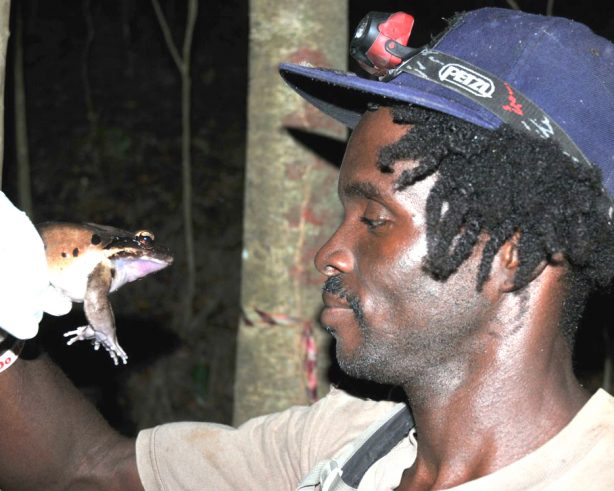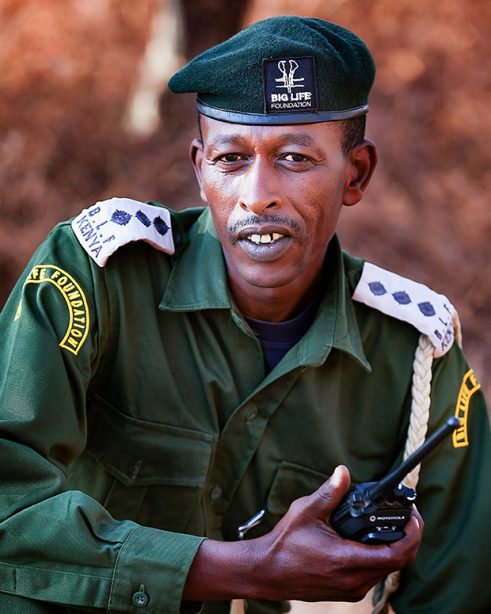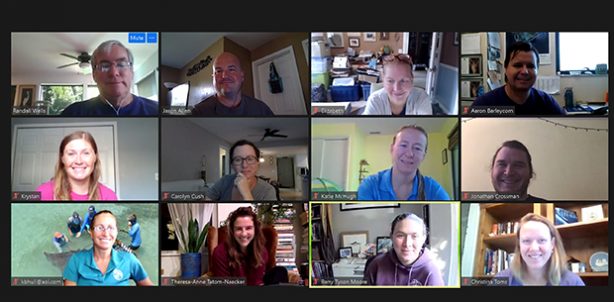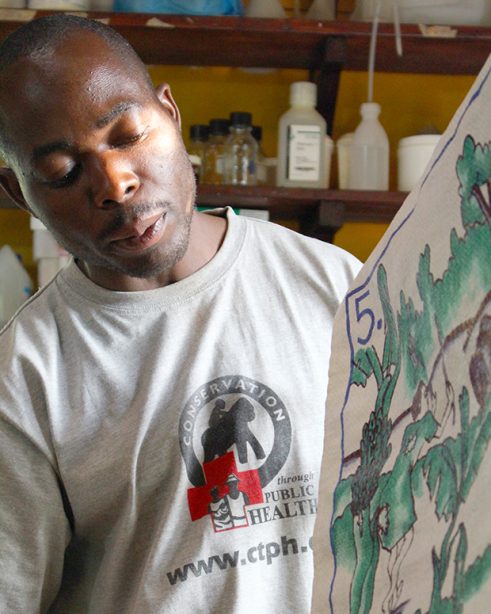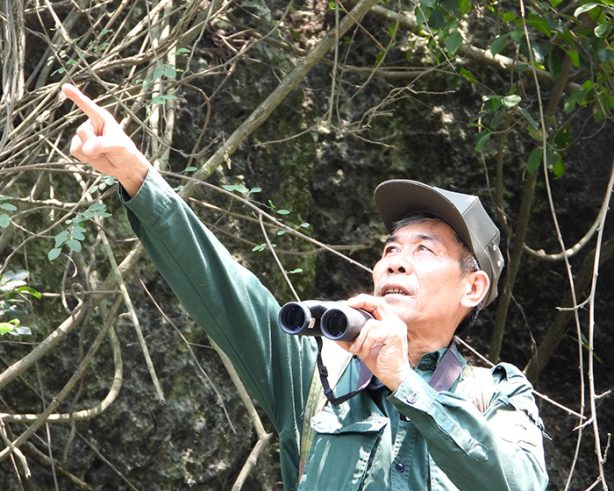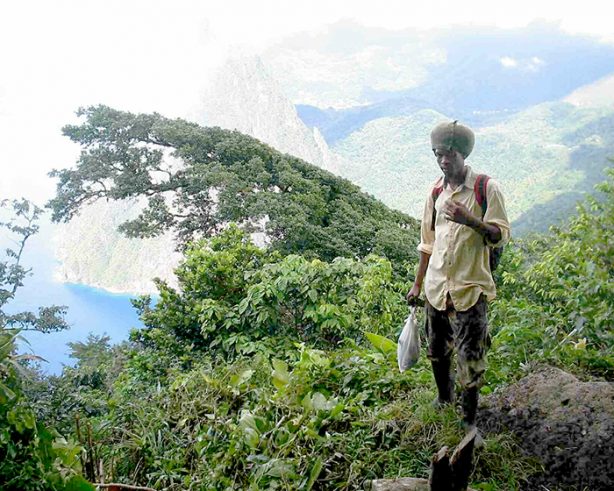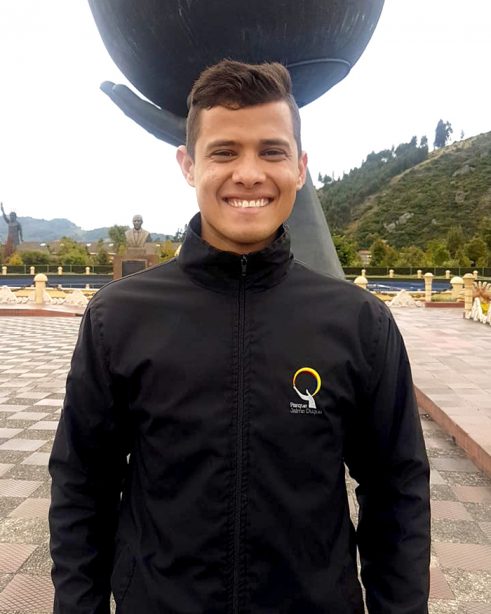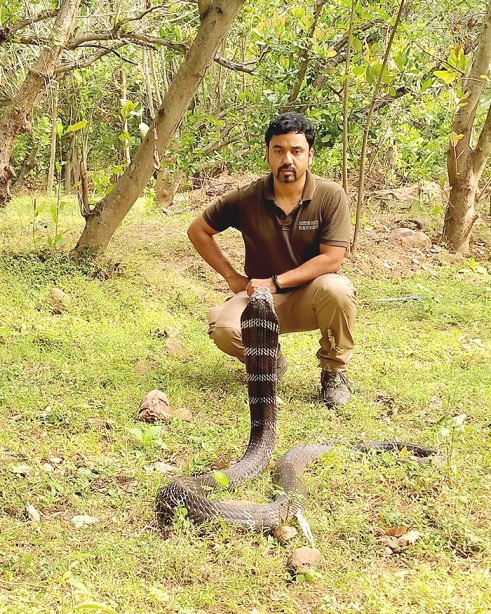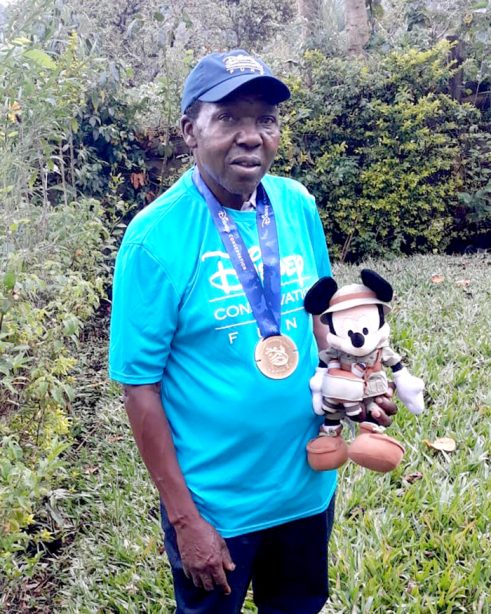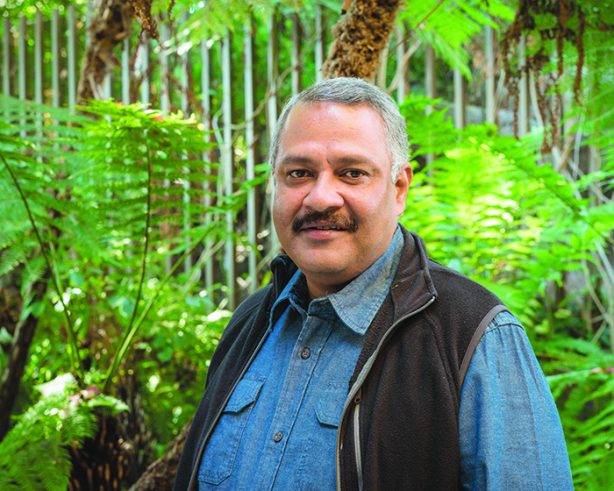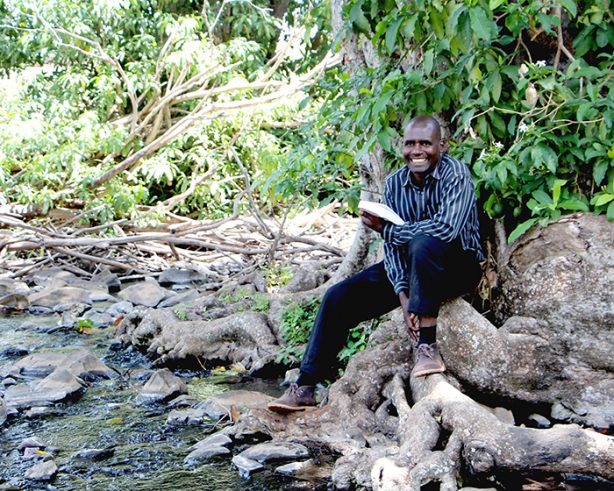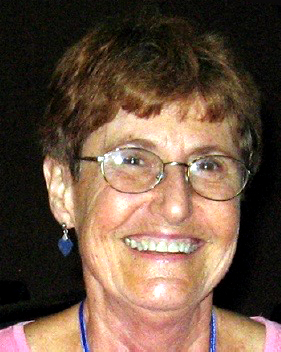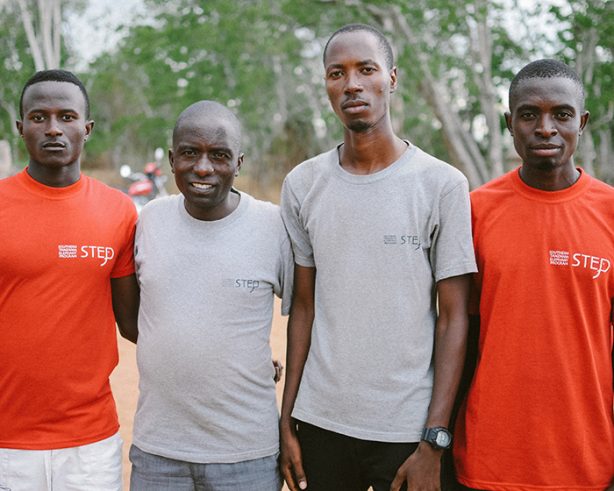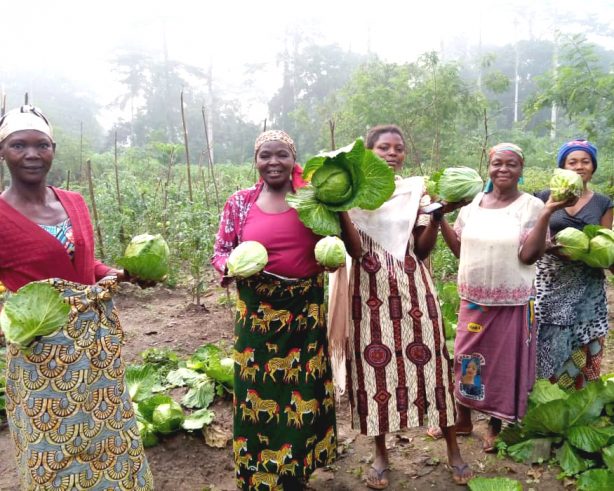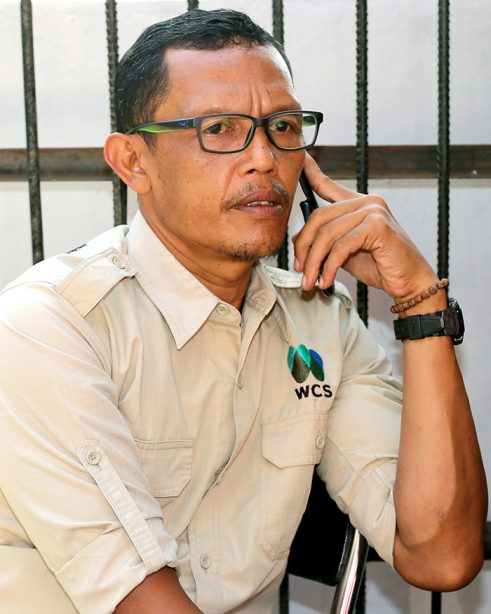The Disney Conservation Fund (DCF) recognizes the hard work and effort of individuals and teams around the world working to conserve wildlife and protect wild places every year. In a world that needs wildlife heroes more than ever, the DCF is proud to celebrate the following 20 individuals and teams awarded in 2020, who join more than 200 passionate, dedicated Disney Conservation Heroes recognized to date in more than 50 countries around the world.
Calvin “Blacka” Fenton
Nominated by American Friends of Durrell Wildlife Conservation Trust, Inc.
Calvin “Blacka” Fenton can often be found awake at 5 a.m. checking wildlife camera traps for five hours, before spending the afternoon tending his goats and returning to the forest at dusk to study critically endangered “mountain chicken” frogs until after midnight—all without complaint and with a smile on his face. Born and raised on the mountain island territory of Montserrat in the Caribbean, Blacka spent his youth exploring the island and learning all he could about his home’s native wildlife and environment. Today he is the go-to wildlife expert and field worker on the island, and his self-learned skills have made him an indispensable asset to numerous conservation projects, visiting researchers and even local hunters—who grew to respect Blacka and follow his guidance to more sustainably hunt the mountain chicken and support the survival of the species. Blacka’s work with the Mountain Chicken Recovery Programme for nearly 17 years has been critical in preventing the extinction of his island’s iconic species.
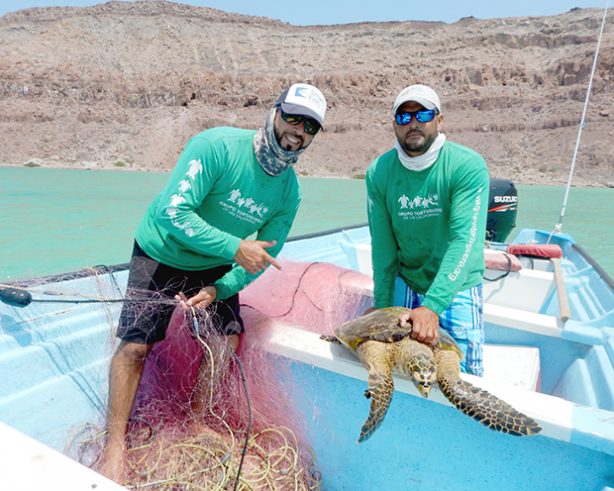
Juan and Felipe Cuevas
Nominated by Arizona State University Foundation for a New American University
Living with only their family on a 2.5 acre island in Baja California Sur, Mexico—two hours away from the nearest human settlement—Juan and Felipe Cuevas grew up fishing and today are two of the most successful fishers in the region. At a young age, the brothers mastered a variety of fishing techniques and began to notice that some methods led to unintended capture and declines of endangered marine species, like sea turtles. They were inspired to take action: Over the past decade, they changed their methods to avoid accidentally capturing sea turtles and other non-target species for only sustainable finfish species, participated in nearly 30 workshops with local fishers to advance sustainable fishing methods and partnered with the Mexican nonprofit Grupo Tortuguero de las Californias to launch a long-term program to protect critically endangered hawksbill sea turtles. They also helped Arizona State University develop the world’s first solar-powered illuminated fishing nets that are significantly reducing accidental catch of endangered sea turtles. The brothers continue to help test and improve design and efficiency of the nets, and support both endangered species and sustainable fisheries globally.
Commanding Officer Francis Legei
Nominated by Big Life Foundation
Officer Francis Legei grew to love wildlife while passing animals as a young boy on his way to school in the Laikipia District of Kenya. After serving as a Kenya Wildlife Service ranger for 15 years, Francis joined Big Life as the Commanding Officer of a team of 300+ rangers working to reduce illegal wildlife poaching over an area of 1.6 million acres in the Greater Amboseli ecosystem. Due to his knowledge, expertise and leadership of an incredible team, illegal poaching of wildlife like elephants and critically endangered Eastern black rhinos has been halted or significantly reduced in Big Life’s area of operation. His job is 24/7 while on duty, often requiring him to be away from family for months at a time. But Francis’ dedication drives him to make the most of this time, building strong relationships between his ranger team and communities to reduce human-wildlife conflict, and collaborating with other partners and local authorities to protect wildlife.
Sarasota Dolphin Research Program Team
Nominated by Chicago Zoological Society
Beginning in 1970, the Florida-based Sarasota Dolphin Research Program (SDRP) team, including co-founder and current director Dr. Randall Wells, discovered that inshore bottlenose dolphins reside in long-term local communities. This important finding allowed the team to dedicate the next 50 years to conducting the longest running study of wild dolphin populations in the world, making incredible contributions to knowledge of dolphin behavior, social structure, health, ecology, communication and the effects of human activities on these complex marine mammals. The team is using their research to help local people get to know their local dolphins as individuals—from creating school curricula to outreach efforts among fishers—ensuring people know how to protect and care for dolphins. The team also helps rescue entangled or injured dolphins, and has trained more than 400 researchers and students from more than 30 countries in dolphin research techniques that are now being applied to protect species around the globe.
Alex Ngabirano
Nominated by Conservation Through Public Health
The world’s population of mountain gorillas recently surpassed 1,000 individuals, changing their conservation status from “critically endangered” to “endangered.” While many celebrated this achievement, Alex Ngabirano saw it as a reason to work even harder. Growing up in the Bwindi community of Uganda, home to 43 percent of remaining mountain gorillas, Alex believes that to protect wildlife, we must also help communities who rely on forest resources to meet the basic needs of their families. Through his work as a field officer at Conservation Through Public Health, training teams to support local community health, grow kids’ participation in conservation and health programs across eight schools and identify community members to train as “gorilla guardians” and community scientists, Alex has helped create a community that respects and protects their environment. Alex’s strong communication and relationship building skills, along with leadership by example, have helped empower his community to improve their own lives and the future of endangered mountain gorillas.
Le Van Hien
Nominated by Fauna & Flora International U.S.A., Inc.
Like many in his rural Vietnamese community, Le Van Hien learned to hunt and trap wildlife at a young age to provide food for his family. He became so well known for his ability to hunt and navigate the Kim Bang forest that he was hired by a visiting primatologist to assist with research on the critically endangered Delacour’s langur. After witnessing the dedication and care the scientists had for this species and others, Hien decided to stop hunting and trapping. Although a better hunter than farmer, he returned to farming and encouraged other hunters to do the same. Now the leader of the local Community Conservation Team, Hien’s work is driven by passion for wildlife and devotion to his community. He is an indispensable resource of local knowledge and biodiversity expertise for scientists, journalists and local groups. He has made real and lasting contributions to the future of the critically endangered Delacour’s langur and has been an instrumental part of a collaborative effort to establish Kim Bang forest as one of Vietnam’s newest protected areas.
Melvin Smith
Nominated by Fauna & Flora International U.S.A., Inc.
Growing up on a farm in the Caribbean island of Saint Lucia, Melvin Smith began studying wild plants when he was 19 years old. With no formal education beyond secondary school, his personal passion drove him to learn all he could about food crops, as well as wild plants and their uses. A born naturalist, Melvin singled-handedly identified 400 new wild plant species previously undocumented on the island. With his incomparable green thumb, Melvin supported the restoration of Sandy Beach coastline by growing 800 individual plants in his own nursery to help revegetate the coast. And upon discovering a small mountain-top population of pencil cedar trees, an endemic species nearly extinct in the wild, Melvin used his extraordinary climbing skills to collect seeds and carefully cultivated 300 new saplings through trial and error, patience and a fierce determination to bring this species back from the brink. A true conservationist, he is not only helping to save rare species but using his extraordinary talents, knowledge and enthusiasm to teach and inspire others to appreciate and care for plants, too.
Nelson Alvarez
Nominated by Fundacion Proyecto Tití
At 13 years old, Nelson Alvarez joined Proyecto Tití’s CARTITILLA school program to learn about critically endangered cotton-top tamarins in Colombia and how to help these special little monkeys that live nowhere else in the world. Through all of Proyecto Tití’s youth leadership programs, Nelson became a talented youth leader, launching a door-to-door campaign to encourage his community to recycle, and organizing community projects to collect more than 1,000 pounds of recyclable materials and more than 2,000 plastic bags. These items that once posed a risk to wildlife were transformed by local artisans into ecomochilla bags sold to help provide families with an income or into durable fence posts used to keep community livestock safe. While pursuing his goal of education to advance his career in conservation, Nelson continues to volunteer, raise awareness and support for both cotton-top tamarins and local artisans and inspire countless kids to be heroes for conservation.
Murthy Kantimahanti
Nominated by Houston Zoo Inc.
Early in life, Murthy Kantimahanti learned his passion for snakes was not shared by many people in his small coastal hometown in India. King cobras, the largest venomous snakes in the world, are critical to a balanced ecosystem; but traditions, superstitions and fear continue to threaten the species. So, Murthy pioneered the first community-based snake conservation program in the Eastern Ghats of Andhra Pradesh. He has trained more than 500 frontline staff of wildlife departments as well as amateur snake rescuers in the state, and taught people from 40 villages over 200 square kilometers to live in harmony with snakes. His efforts are reducing snakebite incidents and unnecessary killings of threatened snake species, and resulted in the first successful rescues and releases of king cobras in the region. His passion even drives him to risk his own safety to continue protecting snakes with his local “snake saviors” in villages during the COVID-19 pandemic, while following all required precautions.
Maurice Wanjala
Nominated by International Crane Foundation
As a boy, Maurice Wanjala spent significant time exploring nature in western Kenya as a scout. He developed such a passion that he created a local community-based organization to protect Saiwa Swamp National Park, home to grey crowned cranes and many other plants and animals. Every day, without funding or means of transportation, Maurice walked to schools, churches and public gatherings to teach about the importance of wetlands and inspire others to join his conservation cause. In 1991 Dr. George Archibald, the co-founder of the International Crane Foundation (ICF), was so inspired by meeting Maurice during a visit to Kenya that he gave Maurice his first grant of $70 to continue his efforts. With it, Maurice bought a bicycle and began riding longer distances to monitor breeding pairs of cranes, establish environmental clubs and expand community work. Now an ongoing partner of ICF, he has established village birder clubs, trained community members to safeguard breeding cranes, expanded awareness campaigns to 32 schools and initiated the planting of 1.2 million tree saplings to protect the wetland area.
Rahul Dutta
Nominated by International Rhino Foundation
Twenty-five years ago, Rahul Dutta sat at his desk and decided he was meant to do more. Inspired by a passion for wildlife, he quit his office job to put his software programming skills to use fighting wildlife trafficking and poaching crimes, and never looked back. Working with several agencies and nonprofit organizations, and currently with International Rhino Foundation, he has helped set up databases to track wildlife offenses, and successfully led and facilitated crime investigations all over the country, including the largest-ever seizure of illegal tiger and leopard parts in India. Rahul recognized that wildlife criminals are only discouraged when held responsible for their crimes, and created an intensive training program in evidence collection and judicial procedures for park personnel tasked with combating poachers. His effective training is in high demand throughout the region and his dedication is helping agencies throughout India and in other countries identify and deter more wildlife criminals and significantly reduce poaching of endangered wildlife.
Ephantus Mugo
Nominated by Lewa Wildlife Conservancy USA
Ephantus Mugo’s passion and dedication have inspired thousands of Kenyan students to become stewards of the environment, all of whom have the potential to develop solutions to the country’s biggest ecological challenges like poaching, deforestation and climate change. When the Lewa Conservation Education Program began, Ephantus worked alone to connect with 20 schools each year. Nine years later, he leads a dedicated team that reaches more than 10,000 students annually by hosting more than 100 school groups for game drives and experiential learning, or supporting Conservation Clubs at an additional 23 local schools. Ephantus also worked with 350 teachers to integrate conservation education into school curriculums and was the inspiration for Lewa to build a 50-room dormitory to host students from low-income areas of northern Kenya and provide a chance to learn firsthand the value of conservation. His efforts to shape students into stewards for Kenya’s vulnerable wildlife such as rhinos, Grevy’s zebra, lions and hyenas are creating a brighter future, as these children become passionate conservationists.
Eleanor Osgood
Nominated by the Los Angeles Audubon Society
After joining a nature club in her mid-30s, Eleanor Osgood became fascinated with birds and the challenges they faced in Los Angeles County, California. This fascination led Eleanor to dedicate the next 30 years to volunteerism with the Los Angeles Audubon Society and the Natural History Museum of Los Angeles County. She tirelessly helped recruit community volunteers, initiated public outreach projects, led local nature walks for the public and helped develop bilingual educational materials to engage her community’s Spanish speakers in bird conservation. Eleanor also launched the “Weed Warriors” project in Baldwin Hills Parklands, a three-mile area of a dwindling and rare coastal sagebrush habitat that is surrounded by dense urbanization. Their work over six years to restore this habitat is providing food and shelter for birds and other wildlife populations, reducing urban runoff, and improving the environmental health of the community. Eleanor’s work has helped to engage people of all ages in the wonders of birdwatching and the importance of restoring and protecting nature within our urban communities.
Brad Rumble
Nominated by Los Angeles County Museum of Natural History Foundation
Elementary school principal Brad Rumble proves that a little bit of nature goes a long way. Working as an educator in the urban core of Los Angeles where very little nature can be found and gang activity is common, Brad partnered with the Los Angeles Audubon Society to transform 5,000 square feet of his campus’ underused blacktop into a “schoolyard habitat.” The restored space became a vibrant living laboratory for students to discover local wildlife and an outdoor haven where children could safely explore. As a result, student science test scores and morale improved significantly, and the project became an example for green spaces in schools throughout the United States. Brad has helped create additional wildlife habitats at a second school, goes out of his way to make himself available after school hours to take families on bird walks and partners with local organizations to give students real-world nature and science experiences. His efforts are unleashing the academic potential of thousands of students and demonstrating the remarkable impact that wildlife habitat restoration and exploration can have on student achievement and on creating a more healthy planet.
Emerson Narciso Neves
Nominated by the Marine Megafauna Foundation
Emerson Narciso Neves’ passion for helping his community began during primary school as he volunteered along the biodiverse coastlines of Mozambique to support local youth, health and the environment. Although Emerson lacked the desired experience for his first position with the Marine Megafauna Foundation (MMF), he proved his dedication and enthusiasm in only six weeks as a volunteer and was given a full-time job. Now a manager, Emerson’s passion for the ocean and diplomatic social skills make him an influential member of the community who is helping to lead MMF’s Sustainable Seas Project to protect wildlife including whale sharks, manta rays, marine turtles and cetaceans. Emerson’s work to train local people as community leaders and launch sustainable tourism and alternative livelihood programs has empowered communities to manage their resources sustainably and reduce pressure on local fisheries. His efforts are also helping to instill a sense of ownership with the fishing community and protect vulnerable species and local fisheries, which in turn protects local food security.
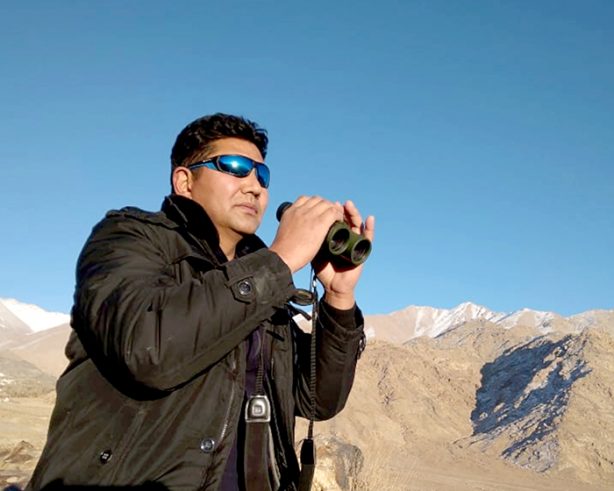
Tsewang Namgail
Nominated by Panthera
In the northern Indian region of Ladakh, home to 60 percent of India’s snow leopards, Tsewang Namgail leads a team of 13 dedicated people along with students and volunteers to reduce conflict between snow leopards and farmers, and find solutions to benefit both through community-based tourism, education and research. Alongside his team, he has helped build snow leopard-proof corrals to protect livestock, promote local food production and expand innovative micro-enterprises like eco-cafes and more than 200 homestays that invite tourists to stay in community homes. These programs help local people earn an income, offset livestock losses to snow leopards and show the value of a thriving population of snow leopards to help increase tourism. Tsewang’s passion for positively impacting this special place where he grew up has helped grow a community-based conservation and education program into a model that has been emulated not just in India, but across snow leopard range in Asia.
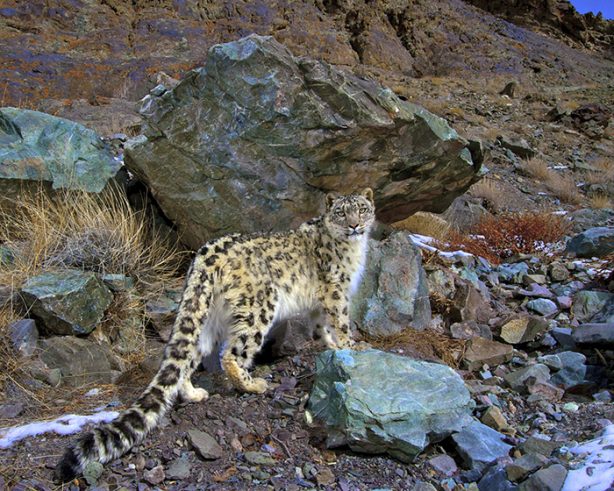
Land of the Snow Leopard Network
Nominated by the Snow Leopard Conservancy
Snow leopard habitat spans 12 mountainous countries throughout Central Asia, each diverse in traditions and culture, and each with their own challenges for big cats. The Land of the Snow Leopard Network (LOSL), comprised of more than 100 members including Indigenous Cultural Practitioners—shamans, sacred site guardians, respected leaders of regional faiths and revered Elders—brings communities together and advances snow leopard conservation while also preserving unique cultures. Four country teams manage the work of educators and spiritual and cultural leaders to promote community wildlife, engage children and parents in multi-disciplinary education courses and nature clubs based on traditional culture and monitor biological and cultural data around snow leopards and poaching incidents. LOSL’s inclusive approach is based on both traditional ecological knowledge and western science. Reviving indigenous cultural practices and attitudes toward sacred species is seen by the LOSL’s members as crucial to conservation. Their efforts have already been impactful in communities where snow leopards have been caught raiding livestock; instead of retaliating, the people have forgiven the cats and released them back into the wild in peace.
Rungwa Human-Elephant Coexistence Team (Abneri Nombo, Shabani Ramadhan, Jonas Jackson, Hamisi Nasoro)
Nominated by Southern Tanzania Elephant
In Tanzania, elephants’ futures depend on peaceful coexistence with humans who share their space and resources. In communities where people often fear and dislike elephants for threatening farms that are sources of both food and income, the Human-Elephant Coexistence (HEC) team bravely collects data on elephant movements, records incidents of elephants raiding resources and risks danger and unpopularity to be a voice for elephant tolerance and understanding. Team members have conducted hundreds of days of monitoring and collected three years of data on elephant activity in the region, often walking long distances alone in remote areas, and working through heavy floods and extreme heat. They have engaged thousands of community members and students in events and education programs, supported programs to boost community economic resilience while helping people and wildlife and helped local leadership use data to reduce conflict with elephants. With smiles, laughter and dedication, the HEC team is helping current and future generations to participate in land use planning to create a more sustainable future for human-elephant coexistence.
Okapi Conservation Project Agroforestry Team (Muvi Yalala, Enckoto Bameseto, Makubuli Mwanika, Masiyiri Mulawa, Mpinda Tchinkunku, Muvi Yalala, Muhindo Muliwavyo, Kasereka Tsongo, Sambi Mukandilwa, Lobo Lina, Nadepa Awelekyalanga and Manbgeto Bambakonda Therese)
Nominated by Wildlife Conservation Global, Inc.
What began as a small effort to combat the degradation of critical forest habitat in the Democratic Republic of Congo has grown into a comprehensive program led by the Okapi Conservation Project Agroforestry Team to empower communities to produce their own food sustainably, improve their standard of living and, at the same time, protect the okapi and its habitat by reducing their dependence on mining, poaching and forest resources. Across five key okapi habitat sites in the Ituri Forest, the team engages more than 500 farmers in a sustainable farming program that has increased crop yields by up to 25 percent compared to traditional methods. They also collect native fruit and nut tree seeds from the forest to grow in nurseries and involve local people in planting tens of thousands of new saplings each year, instilling a love and appreciation of nature in local children and ensuring forest habitats for wildlife. True leaders in their communities, this team has even increased distribution of supplies and adapted strategies to support communities safely during the COVID-19 pandemic.
Tabah
Nominated by Wildlife Conservation Society
Motivated by a volunteer opportunity that led him to witness how wildlife trafficking was negatively impacting wildlife, Tabah has spent more than two decades supporting forest-edge communities in reducing conflict with threatened wildlife including tigers and elephants in and around Bukit Barisan Selatan (BBS) National Park on the Indonesian island of Sumatra. Tabah has supported research to find win-win solutions for wildlife and people, helped resolve more than 370 human-wildlife conflict cases in more than 50 villages surrounding BBS, aided communities in building nearly 200 tiger-proof livestock enclosures to reduce conflicts with wildlife, educated communities and deescalated conflicts that would otherwise result in retaliation against critically endangered Sumatran tigers. His personal approach has gained him trust and respect among communities, and his dedication has shown clear and positive results with reduced frequency of human-tiger conflicts across the landscape and surveys once again showing a healthy density of tigers in the core forest areas of the park.
